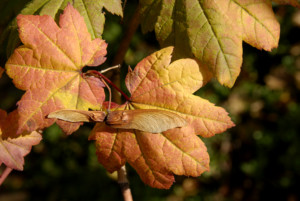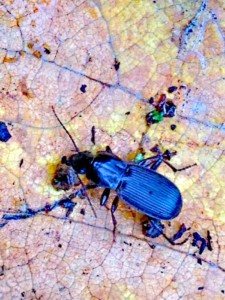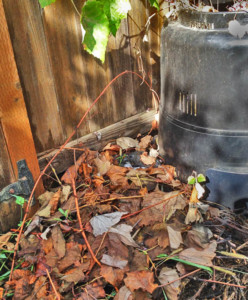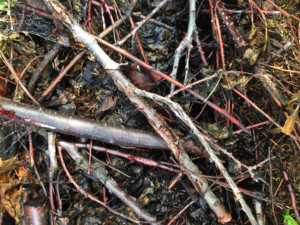 [/media-credit]
[/media-credit]
“Let the leaves fall where they may.”
By Miko Ruhlen. Nov. 3, 2016.
Dead plant stalks, decaying plant debris, and leaf piles are nurseries for insects that in the springtime will pollinate flowers, keep pests in check, and create a balanced and sustainable garden. Birds will be sustained through harsh Gorge winters by seed heads and fermenting berries, and utilize brush piles or dead trees for forage and cover. Leaf piles protect roots from winter freezes and amend the soil as they break down; at the same time they shelter and nourish small overwintering creatures like toads, newts, earthworms, and beetles.
 [/media-credit]
[/media-credit]
On the topic of beetles and yard clean-ups, “Carabid beetles, Carabid beetles and Carabid beetles!” emailed Drew Merritt of Humble Roots Farm and Nursery in Mosier, Oregon. “This large family (Caraboidea, 2000 species in North America) of insects is composed of some of our best pest controlling beneficial insect species. These ground beetles will eat any invertebrate they can overpower and are very effective for many orchard pests. The most familiar species in our area are black and shiny and you can usually find them under rocks or in decomposing vegetative matter, especially the thatch left by grasses, which is why it is important to leave a bit of a mess around the garden. Also many species will lay their eggs in the hollow canes of spent herbaceous plants such as Goldenrod and Fireweed as well other pithy centered plants. Remove all the ‘debris’ from your garden and you could be removing the nursery grounds for the next generation of a very important component of a balanced garden ecosystem.”
Consider balance in your backyard ecosystem and your busy schedule. Spend more time watching the leaves change colors or with the kids romping in piles of leaves. Spend less time raking, cutting, shoveling, or hauling. Let the leaves fall where they may.
Tips for fall yard ecosystem enhancements:
 1. Make a leaf pile several inches thick in a corner of the yard. This will invite hibernating critters and the leaf mold can be used as a soil amendment in the spring.
1. Make a leaf pile several inches thick in a corner of the yard. This will invite hibernating critters and the leaf mold can be used as a soil amendment in the spring.
2. When clearing paths for safety, Instead of raking leaves and just throwing them away, use them in your garden beds as mulch, compost them or bring them to a local recycling center that accepts yard trimmings.
3. Instead of cutting plants down to the ground, leave the stalks standing a foot or two high. Many butterflies, mason bees, and predatory insects (like ladybugs) hibernate in leaves and stalks. Predatory insects help maintain a balanced insect population reducing unwanted infestations.
4. Leave fermenting berries and fruit, seeds, and seed heads for wintering birds and small animals to eat. Leave dead trees standing to provide shelter and nesting cavities for birds and bats.
 5. Make a small brush pile with fallen or pruned branches and leaf litter to provide cover and foraging areas for birds, reptiles, and insects.
5. Make a small brush pile with fallen or pruned branches and leaf litter to provide cover and foraging areas for birds, reptiles, and insects.
6. Fall is also a great time to plant natives in your yard. The rainfall this time of year helps give them regular water to establish, reducing irrigation needs in the spring or summer, therefore conserving water.
Thank you to our advertisers and sponsors!






